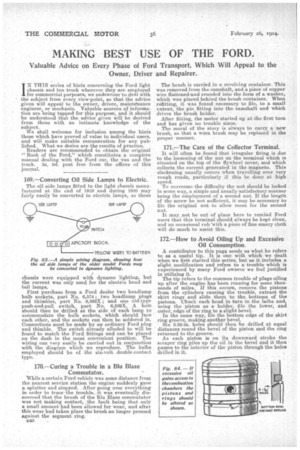MAKING BEST USE OF THE FORD.
Page 24

If you've noticed an error in this article please click here to report it so we can fix it.
Valuable Advice on Every Phase of Ford Transport, Which Will Appeal to the Owner, Driver and Repairer.
IN THIS series of hints concerning the Ford light chassis and ton truck wherever they are employed. for commercial purposes, we endeavour to deal with the subject from every view-point, so that the advice given will appeal to the owner, driver, maintenance engineer, or mechanic. Valuable sources of information are being tapped for this purpose, and it should be understood that the advice given will be derived from those with an intimate knowledge of the
subject. We shall welcome for inclusion among the hints those which have proved of value to individual users, and will make suitable remuneration for any published. What we desire are the results of practice. Readers are recommended to obtain the original "Book of the Ford," which constitutes a complete manual dealing with the Ford car, the van and the truck. es. 9d. post free from the offices of this journal.
169.—Converting Oil Side Lamps to Electric.
The oil side lamps fitted to the light chassis menu. textured at the end of 1919 and during 192O may fairly easily be converted to electric lamps, as these
chassis were equipped with dynamo lighting, but the current was only used for the electric head and tail lamps.
First purchase from a Ford dealer two headlamp billb sockets, part No. 6,574; two headlamp plugs and thimbles, part No. 6,592X; and one old-type push-and-pull switch, part No. 6,589X. A hole should then be drilled at the side of each lamp to accommodate the bulb sockets, which should face each other, and the sockets can then be soldered in. Connections must be made by an ordinary Ford plug and thimble. The switch already alluded to will be found to match the Ford fittings and can be placed on the dash in the most convenient position. The wiring can very easily be carried out in conjunction with the diagram which we reproduce. The bulbs employed should be of the six-volt double-contact type.
170.—Curing a Trouble in a Blu Blaze Commutator.
While a certain Ford vehicle was some distance from the nearest service station the engine suddenly gave a splutter and stopped. After going over everything in order to trace • the trouble,. it was eventually discovered that the brush of the Blu Blaze commutator was not making contact, the fault being that only a small amount had been allowed for wear, and after this wear had taken place the brush no longer pressed against the segment ring.
C40 , The brush is carried in a revolving container. This was removed from the camshaft, and a piece of copper wire flattenedeand rounded into the form of a washer, which was placed behind the brush container. When refitting, it was found necessary to file, to a small extent, the pin fitting into the camshaft and -which drives the brush holder.
After fitting, the motor started up at the first turn and has given no trouble since.
The moral of the story is always to carry a new brush, so that a worn brush may be replaced in the proper manner.
171.—The Care of the Collector Terminal.
It will often be found that irregular firing, is due to the loosening of the nut on the terminal which is situated on the top of the flywheel cover, and which collects the current generated in the magneto. This slackening usually occurs when travelling over very rough roads, particularly if this be done at high speed.
To overcome the difficulty the nut should be locked in some way, a simple and usually ,satisfactory -manner being the employment of a second nut. If the length of the screw be not sufficient, it may be necessary to file the original nut to allow room for the second nut.
It may not be out of place here to remind Ford users that this terminal should always be kept clean, and an occasional rub 'with a piece of fine emery cloth will do much to assist this.
I72.—How to Avoid Oiling Up and Excessive Oil Consumption.
A contributor to this page sends us what he refers to as a useful tip. It is one with which we dealt when we first started this series, but as it includes a slight modification and refers to a trouble which is experienced by many Ford owners' we feel justified in utilizing it.
The tip refers to the common trouble of plugs oiling up after the engine has been running for some thousands of miles. If this occurs, remove the pistons from the cylinders causing the trouble, extract the skirt rings and slide them to the bottoms of the pistons. Chuck each head in turn in the lathe and, using the piston as a holder, file the lower, and outer, edge of the ring to a slight bevel.
In the same way, file the bottom edge of the skirt ring groove, making another bevel. Six 3-22-in. holes should then. be drilled at equal distances round the bevel of the piston and the ring returned to the groove. As each piston is on its downward stroke the scraper ring piles up the oil in the bevel and it then passes to the interior of the piston through the holes drilled in it.






























